Love's Epic Food Journey: Starting With Sourdough, Make your own Sourdough Mother and your first loaves of bread, Step by Step
If you believe bread is not good for you then
let me tell you about sourdough,
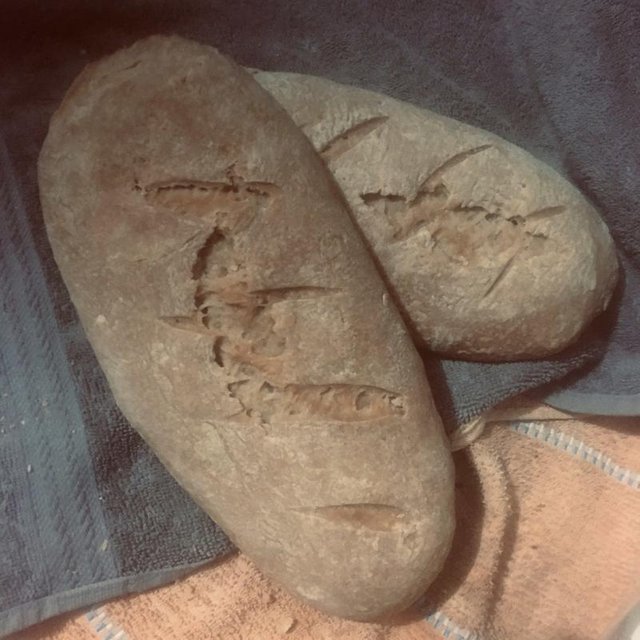
the way bread was intended to be.
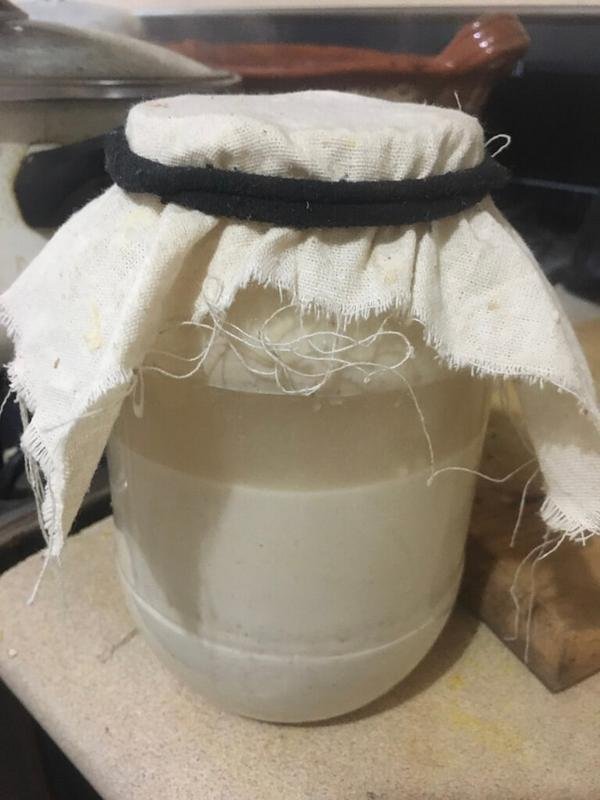
Sourdough bread is REAL bread.
The first breads were made this way...for thousands of years.
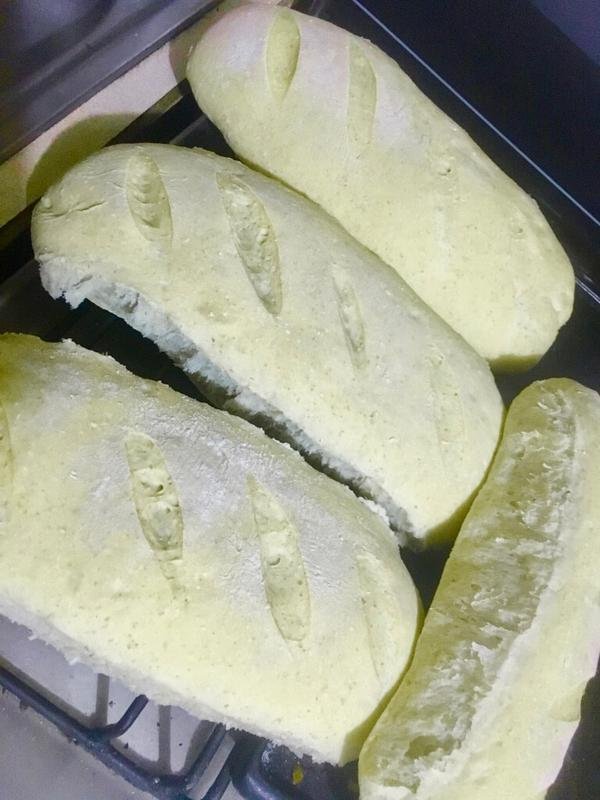
The yeast you buy in the store and the breads you see in plastic bags
would make Old World bread artisans roll in their graves (the dead ones, that is)
if they only knew what humanity is passing off as bread today.
Those who enjoy foods like Kombucha and Kim Chi
will love the world of fermented breads.
Once you learn the basic process of catching yeast,
maintaining a starter and
making the breads then it is possible to really
play with it
and develop your own signature rustic breads.
I encourage you to learn about sourdough science and bacterias.
Do a Google search for “sourdough science pdf”.
You will find a long list of PDFs explaining every aspect of sourdough imaginable.
Download for studying and referencing.
Some interesting facts about sourdough:
- The early gold miners carried around a jar of sourdough starter because the separated liquid on top makes a strong whiskey, thus the name “doughboys”.
- Many southern european families have starters that have been passed down through the family for countless generations.
- A sourdough starter is like a family member, as it must be fed and stirred everyday.
- A portion of the family sourdough starter is given as a traditional wedding gift to continue the bread line.
- Sourdough is full of bacterias that regulate digestive enzymes, boosts the immune system and aids in optimal digestion.
- Every place you go in the world will have a different yeast flavor. For example: If I take a starter that tastes really good from the mountains of Colorado to the deserts of Arizona the yeast will have a different taste.
- Old places catch the best and most yeast such as old neighborhoods, old houses, rooms with lots of old stuff.
- There’s not many rules to maintaining a starter so there’s lots of “wiggle-room” to play with it.
When I was a small child I began to learn to bake bread.
It wasn't until I was a young adult that I discovered sourdough.
SInce then I have created many successful sourdough starters.
The first ingredients are persistence, dedication and passion.
For the first few months it’s really important to
feed your starter every day,
stir it a couple of times and make something...anything, with the starter.
It’s true, you could just pour it out to feed it but
that’s wasteful and unadventurous.
Everyday, when developing a new starter,
you will stir it then several hours later stir it again
but this time pour half of it out, replace the liquid and
feed it by stirring in flour until it’s a loose pancake mix consistency.
Always cover your glass starter jar with a piece of cloth
fastened tightly around the neck with a rubber band.

Things you can make with the discarded liquid of a developing starter:
- Bread (you will have to add store bought yeast in the beginning)
- Pancakes (add baking soda and baking powder)
- Banana pancakes
- Biscuits
- Crackers
- Quick breads
- Scones
- Cookies
Do a search for more sourdough recipes. Experiment with substituting the liquid for the starter.
To make a starter you will need:
- A quart jar with large mouth
- Clean pure water
- Flour (all-purpose, unbleached white or bread flour)
- Sugar
- Yeast
Piece of cloth that easily covers the jar mouth
Rubber band for fastening the cloth around the jar neck.
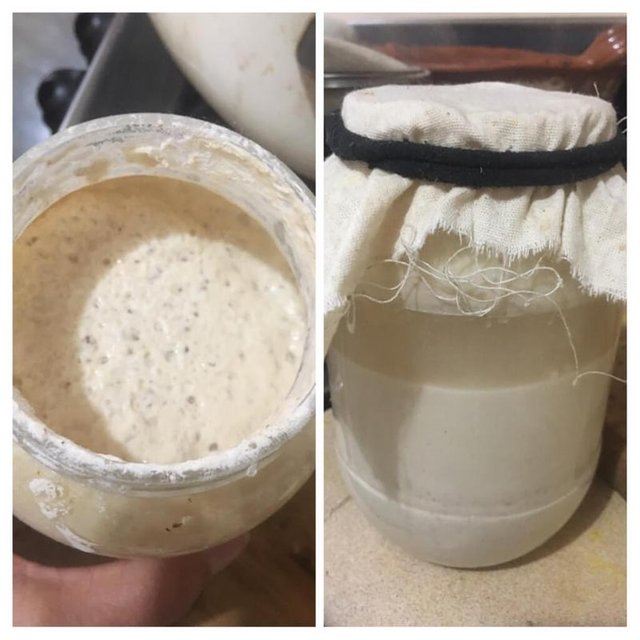
Fill the jar ¾ full with water.
Add about a Tablespoon of sugar and
a pinch of yeast (this is the only time you will ever add yeast).
Stir with a non-metal spoon.
Add flour and stir until the starter has a milky pancake mix consistency.
Don’t worry. It’s really hard to get this wrong.
Store it in a warm place.
My favorite is on top of the refrigerator.
Stir and feed it everyday.
It's a living thing therefore, it's a new family member.
Go ahead, give it a name...something like, Clint Yeastwood.
When it’s about a month old you will notice the flavor
of your bread starting to develop the sour flavor.
At this time, it will likely also start producing bread with a noticeable
spongy texture and a beautiful crispy crust.
When this begins it’s time to make the bread without adding store bought yeast.
Begin the bread making process early in the morning
as it will take a full day.
However, I promise, it will be worth it.
SIDE NOTE: There are many ways to make sourdough bread. This is my method.
Basic Sourdough Bread process:
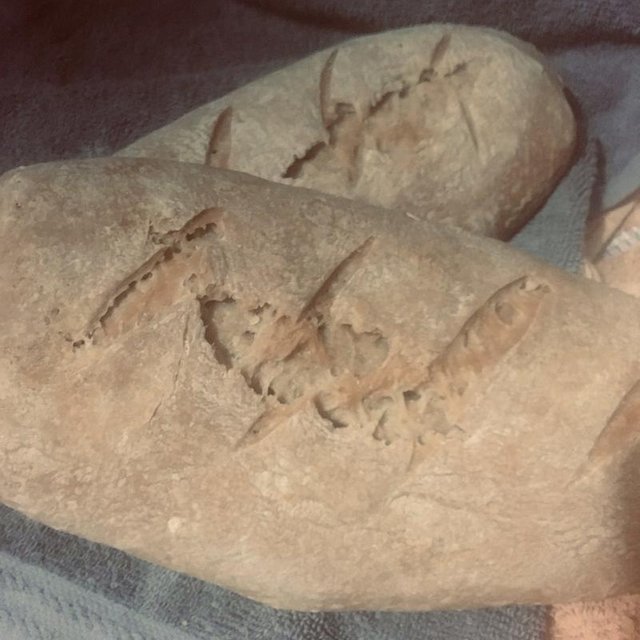
Begin by making a “sponge”.
Stir the starter thoroughly then pour half of it in a large non-metal bowl.
Add about ¼ - ½ Cup of liquid(water, milk, apple juice, potato water, etc.,.).
Next, add 1 - 2 cups of flour. I like to add my oils at this point but it can wait.
Stir in about 2 Tbls. - ¼ cup of sweetner. Honey, sugar, maple syrup, molasses, etc.
The purpose is for food to attract more wild yeast and
not necessarily to make the bread sweet.
Add more liquid or flour to create a thick pancake mix consistency.
Cover with a towel then set a warm sunny location for 2 - 6 hours.
Stir every 2 hours. The longer it sets, the more yeast it will catch,
the better texture and flavor of the bread.
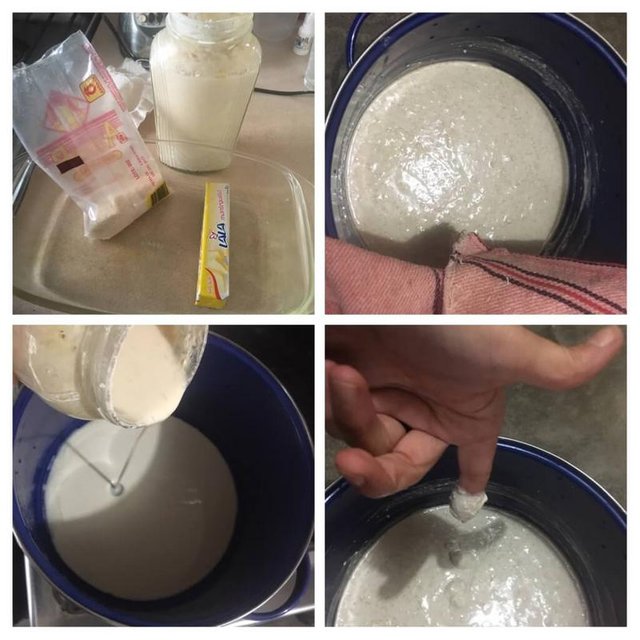
REMEMBER: Feed the starter after you use half of it.
Replenish the water and flour you removed . Stir. Cover.
Making the Dough:
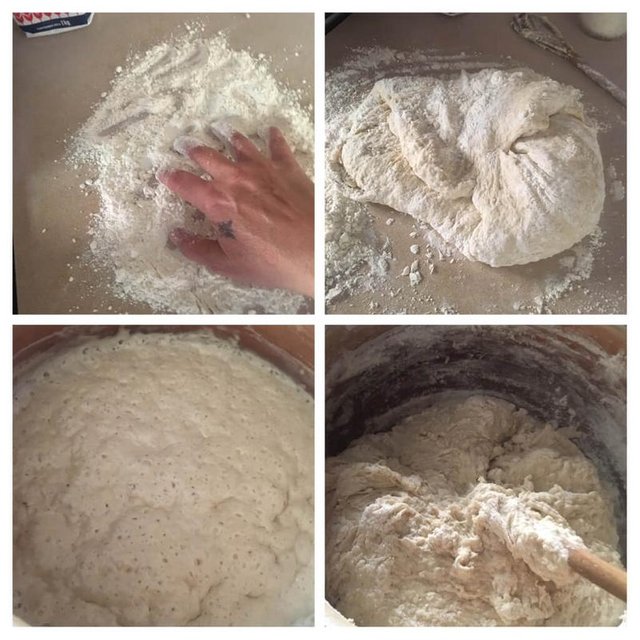
Stir down the sponge.
Add salt and the oils if you did not earlier.
I prefer olive oil, butter or coconut oil.
SIDE NOTE: Cheap oils such as canola or soy oils are not only bad for your body
but are in conflict with the whole system of bacterias of the sourdough.
So, basically, if you use poor quality oils all the great health benefits of sourdough
are sabotaged by introducing poor quality ingredients.
Please don’t offend the hard earned healthy bacterias.
Now it's time to add any specialty flours. My rule of thumb is
I never use anymore than 40% specialty flour.
The more white flour you use the fluffier the bread will be.
The more other grains you use the denser your loaf will be.
So, just keep in mind as you’re playing with your ratios of
white flour to other, special grains; the white flour
creates the fluff and other grains weigh it down.
Other grains to consider:
- Whole wheat
- Fine cornmeal
- Pulp from your almond milk or coconut milk
- Oatmeal
- Boxed cereals that have been pulverized such as Corn Flakes or Shredded Wheat
- Cooked potatoes
- Cooked rice
Continue by adding a couple cups of flour and stirring in then repeating
until dough pulls together into a ball and is no longer stir-able.
Put a handful of flour on a clean table then dump your dough on top of it.
KNEAD: The purpose of kneading is to work a little more flour into the dough so it’s no longer sticky and to fold air into it, activate the gluten process. Kneading looks easy but it's one of those things that can really take a lot of practice before you develop your own dependable kneading rhythm. I first began kneading as a child but didn't really master it until early adulthood.
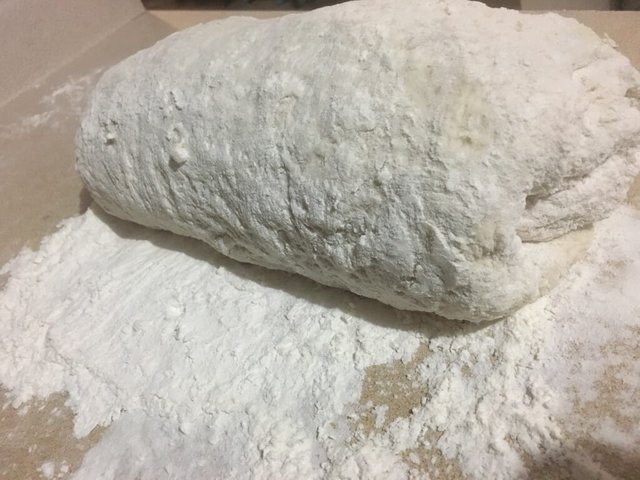
When you first begin kneading the dough there will be a bit of focus
on incorporating more flour. At some point you will notice the dough
becoming considerably less sticky.
At this point, only add a sprinkling of flour as needed.
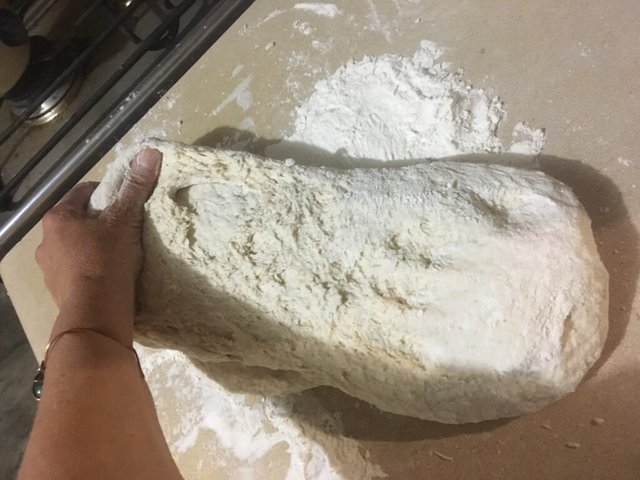
Begin by stretching away from you then fold towards you.
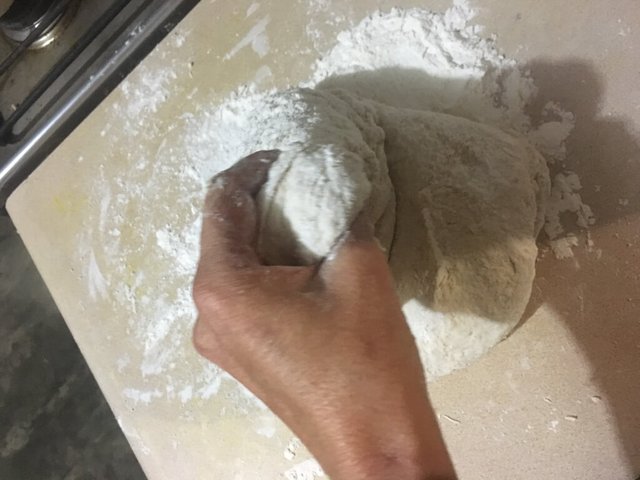
Push down with the heel of your hands. (I am holding the camera
with one hand but ordinarily kneading is done with 2 hands.)
Then turn the dough a 1/4 turn.
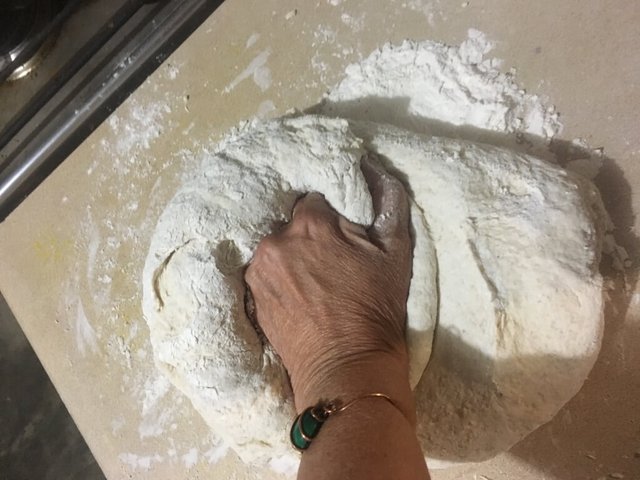
In simple form, it's: Stretch, fold, push, turn. Stretch, fold, push, turn.
When the dough is no longer sticky but is smooth and
beginning to show elasticity, add only a sprinkling
of flour to your working surface.
Stretching the dough is also no longer necessary. Just fold, push, turn.
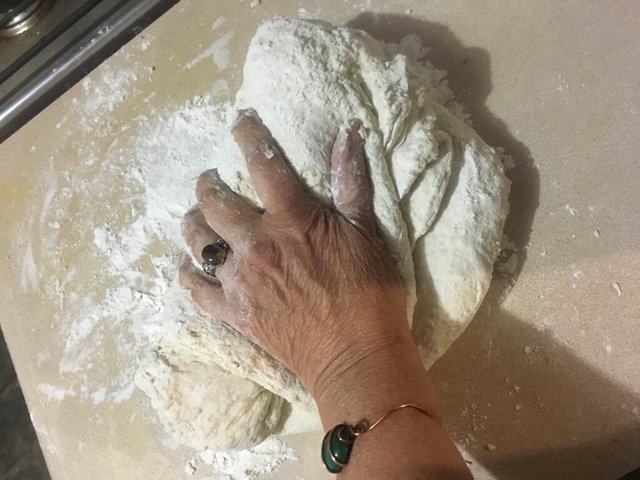
Kneading looks easy but it is a skill.
The following video is a short demonstration of
kneading in action and a glimpse of
the sounds of a kitchen in Monterrey, Mexico..
When you feel you are getting close to finishing the kneading
(10-15 minutes is normal) let your dough rest while you clean the
mixing bowl and oil it very well. After about 10 minutes of
resting finish up the kneading.
The dough will be very smooth and elastic.
You should be able to pull on a chunk of the dough and it will spring back.
The following video is a quick visual of elastic dough.
Put the kneaded dough into your prepared bowl,
top side down, swirl around then flip it over.
Check out this super short video for a
visual of what that actually looks like.
Cover with a towel then let rise until doubled in a warm place, 2 - 10 hours, until doubled.
If it's a warm sunny day then set it outside in the sun.
A really active yeast will double quickly but could have less sourdough flavor.
A less active yeast will take longer but develops a really delicious sourdough flavor.
When the dough has doubled give it a punch to knock it down.
Pinch the dough in half for 2 loaves or
cut into 3 - 4 equal pieces for more loaves.
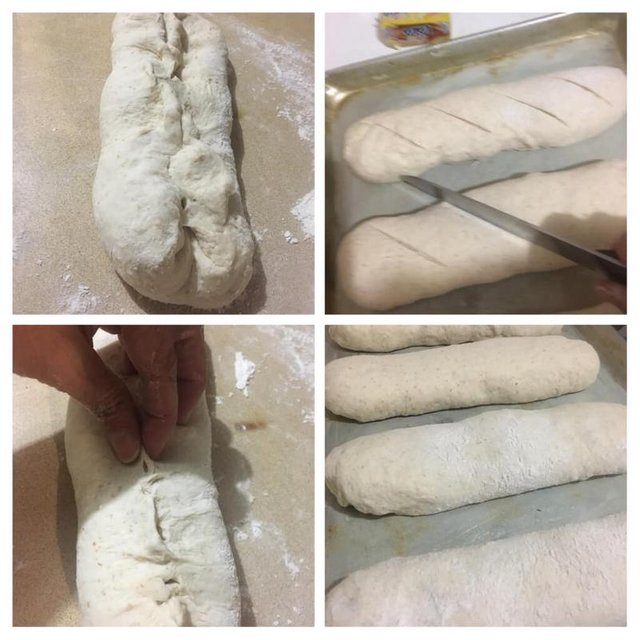
Form your loaves into the shape you want.
You can do rounds, logs or place into a
well oiled pan to make other shapes.
Sometimes I use cast iron or terra cotta flower pots.
Whatever you use, make sure it is well oiled
before you place the formed loaves on it.
Try sprinkling cornmeal on the oiled surface to create a yummy crust.
Be creative.
Cover the top of the loaves with butter, egg wash or oil.
Sprinkle with sesame seeds or sea salt if you want.
Cut slits in the top but no deeper than a 1/4".
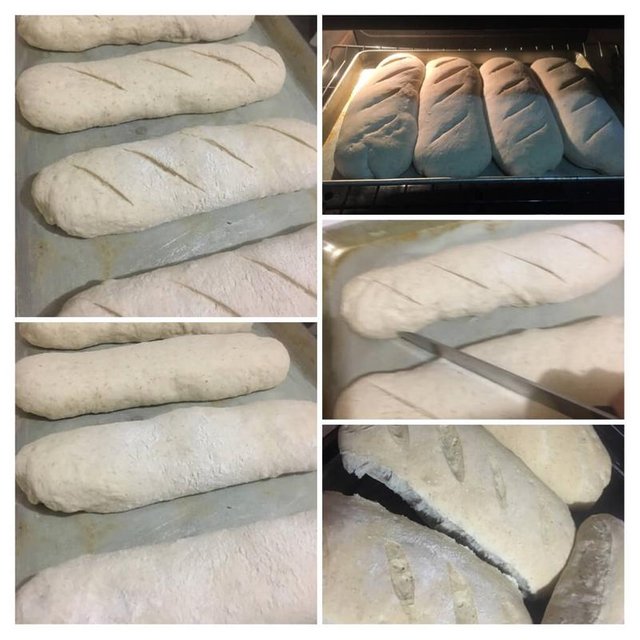
Cover the prepared loaves with a towel, place in a warm place for 2- 10 hours,
until they have risen about double.
I like to set mine in a cold oven to rise then gently
remove the towel and turn on the oven.
Starting in a cold oven gives the bread just a little more rise.
Heat the oven to 450 then after about 20 minutes turn it down to 350.
If you put bricks soaked in water in the
oven the steam will create a beautiful crust.
The loaves are ready when you can finger thump the
loaf and it sounds like a hollow wall.
Immediately set on cooling racks, not a solid surface,
so the bottoms do not become soggy.
Store in paper bags or wrapped in cloth.
Enjoy!
~-~-~-~-~-~-~-~-~-~-~-~-~-~-~-~-~-~-
Keep Following.
I got many more fun-believable food experiences,
and amazing adventures.
I'm serious!
My stories are continuously unfolding as
I continue my unique journey through Latin America.

Your UpVote, Follow, Repost and Comments support me to keep the...


Hi there,
I've just upvoted this post
A small contribution from me, to help the steem community to thrive ;)
Grateful for the contribution and support. I would love to hear about your baking experiences.
Loving the Steem!
ehehe, I can bake some chicken with potato, and fish.
My wife is a great baker, she bake fantastic pies and cakes, bread and anything you can think
Sounds like you are the official taster and enjoy-er of your wife's excellent cuisine. Good for her that she has a consumer of her addiction.
well in reality lucky me to have her! And not just for the food, but literally for everything...
Well that was sad for me to see and read. I am in SE Asia where the concept of bread is not well developed. That is about the kindest thing I can say about it. In the last few years I have only eaten bread a few times, and it is very disappointing each time I do.
I used to bake my own bread after I found out how easy, nutritious, and cheap it was compared to the garbage on the shelves. I never tried sourdough, but yours looks fantastic. Like you, I found out some white flour was necessary along with the specialty flours.
You have a wonderful post; so jam packed with information. I bookmarked it in case I am ever lucky again to bake again :)
You can do it! You can do it!
Give it a try. Be patient with yourself and loosen your expectations at first. That is, give yourself permission to bake imperfection at the beginning. It's okay. Just turn it into bread pudding or french toast.
Fluffy white bread, I hope, will be a thing of the past soon.
Keep on Steeming! I love the feedback.
I would love to do this, but we don't have ovens here! I would need to do flat bread maybe or possibly learn to steam it. But the street food is so cheap, I probably won't be baking in this phase of life.
I don't eat the bread here, but I am on overdose levels of rice lol.
During my travels through Latin America and while I was the main chef at @gardenofeden The Garden of Eden I didn't have an oven either but I've come up with many methods for making grilled and fried breads and crackers.
I sometimes feel like I'm on rice overdose in Latin America too..
A couple people have expressed an interest in no-baking bread items so I'm considering writing another sourdough blog on how to make the no-baking breads using the sourdough.
That would be wonderful. Please keep my name so that if you do that you can tag me, or feel free to drop a link in a comment on any one of my posts. It's so hard to keep up here, and I would really be interested in these posts and recipes.
In the kitchen I have now the woks are big enough to wash your small child in. You should see me fry an egg lol :)
What a lovely post!! Man this is so full of information and I loved every minute of it. I really enjoy making bread and have teaching someone how to make it is such a visual process and you covered that so well here. Thanks for this! You’ve inspired me to whip up some sourdough bread 🙌🏼
Hooray! I love that you're inspired to catch your own yeast.
You go Gurl. Let me know how it goes.
Once you get started it can become a healthy addiction.
Steem on!
Hello there!!
It was nice reading and learning the true and genuine bread making. I am not a professional baker but I know how to bake a few. I did try to make a bread and I always fail, epic fail. My bread turns to cookie hahahahahahaha.. and to think that was just the simplest recipe to follow.
But anyway, reading through all the instructions on how to do the Sourdough Bread, I was reading intently for it is very meticulous and great effort in making this bread. I know for sure that it tastes more than the bread we usually have.
Yes kneading takes extra skills, if you dont know how to, you cannot really reach the bread rise you wanted.
I wish I could taste that bread.. I will look for it in my area, I hope I could find one.
Thanks for sharing, I have learned a lot.
Cheers!
It was these od style breads that people could live on bread and water.
Today's plastic bag faux breads won't sustain anything.
I'm really grateful to hear that my directions are clear and the blog is informative.
Your feedback is very useful.
Go ahead and give it a try again. There's several great Facebook groups for baking bread that can help you figure out what went wrong...but, who doesn't love cookies.
Steem on with the baking!
It is! And we are grateful for this kind of post. I was really interestes how it was suppisedly made.
Posted using Partiko Android
Let me know how your next attempt comes out. I bet the next one will perfect!
I wish i would have the time this holidays.. ❤
Posted using Partiko Android
Congratulations @loveon! You have completed the following achievement on the Steem blockchain and have been rewarded with new badge(s) :
Click here to view your Board of Honor
If you no longer want to receive notifications, reply to this comment with the word
STOPDo not miss the last post from @steemitboard:
Great! Love to see the progress.
Your post is great and lots of great instructions for people new to Sourdough. I also make sourdough but I use the no knead version xx
Posted using Partiko Android
I've never heard of the no-knead version*.
I will check it out.
I love meeting other weirdos who are into catching yeast. (wink)
I love the feedback. It's great to know my directions are perceived how they were intended.
Loving the Steem!
Glad you love it! I do too. It's a crazy place but lots of fun and you meet cool people.
The no knead version is great - I mean, there's a BIT of kneading at end but not alot.
Basically you mix it and leave it for about 8 hours til all bubbly and risen - then you fold a couple of times, put in your proving basket for another hour or two or even overnight in the fridge, then pop in your dutch oven and voila!
...and it comes out with a nice texture and good flavor? Sounds interesting.
Yes, it's perfect!
https://cooking.nytimes.com/recipes/11376-no-knead-bread
This is interesting. I noticed you have some yeast and sugar in your sourdough starter, but have you created a sourdough without any added yeast? At simplest, you could create a sourdough from only plain water and flours, but I've usually added a little bit of shredded apple..
So my sourdough starter comes from water, wholewheat flour and a little bit of shredded, organic apple. I wouldn't recommend this if one was allergic to apples, even though the apple will disappear completely from the sourdough after a few times you've used it and re-created it.
Still, this is a nice post :)
I only add a tiny bit of yeast to a brand new starter to get it going. I bake bread with the starter and add a little yeast for the first month or so. The loaves in the photos are completely free of store bought yeast unless you want to count the finite molecular amount that might still be in the starter from day 1. I use the starter almost everyday so I doubt there's enough in there to count it. It's just to get the starter started.
I understand it is possible to start a starter without added yeast. I actually throw all kinds of unconventional things in my starter. Boiled potatoes and potato water, old cooked rice, sweet potatoes, pumpkin puree, banana, etc. They say around here to not leave anything on your plate or Love will take it and put it in the starter or the bread dough.
Love the apple idea. I bet that's tasty.
Keep on Steemiting.
I do see the benefit of your style, you still get the sourness in the dough with that. I'm not sure how large differences you can see if you will use different ways to start the dough. But I would recommend to try the apple version sometimes!
The point of using organic apple (or other fruit) is that there's natural yeast in the apple and the peel. That's why it's important it's not sprayed with pesticide and such and why it has to be fresh and not cooked.
But as mentioned, I do not know if there is ultimattely much difference. There might be, as we have many different kinds of yeast in the world :)
I love Sourdough Mother but I am not costant to follow it. However I like the taste in the bread and in the biscuits.
There is a famous bread in Italy that has it inside and It Is made in Altamura, South Italy.
STEEM ON!
Posted using Partiko Android
I think yeast breads originated in Italy or France. Families have mothers that are hundreds of years old. Pretty amazing!
Grateful for the comment.
Yes, it is a lot of work if you are not passionate.
Keep on Steeming!
I did not know that news.
It Is great.
You are welcome and I say thank to you for your content!
Posted using Partiko Android
Hi loveon,
Visit curiesteem.com or join the Curie Discord community to learn more.
Wow! I'm very grateful for the feedback. It feels great to have my hard work recognized.
Good read to get to know sour dough baking journey. Resteemed! If you have spare space for #breadbakers next time, it would be nice you use the tag so that Steemit bread baking fans get to know your post :)
Great to know there is a hashtag for bread baking. Thanks for the tip.
I will soon be writing a blog on my whole grain sourdough coconut crackers.
Super grateful for the Resteem!
Keep on Steemy baking.